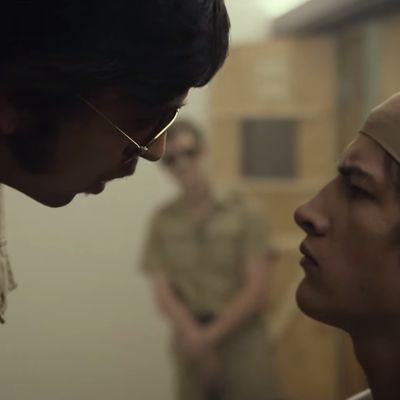
Kyle Patrick Alvarez’s The Stanford Prison Experiment is a mostly faithful dramatization of an infamous 1971 study conducted by Stanford psychology professor Philip Zimbardo (played by Billy Crudup in the film), in which 24 male students were selected and paid $15 a day to pretend to be captives and guards in a simulated prison environment. The results, without giving too much away, were eye-opening: The subjects took to their roles so well that the study has gone down in history as a demonstration of how authoritarian systems operate.
The original experiment has inspired a number of movies, books, and plays, among them Oliver Hirschbiegel’s intense 2001 film Das Experiment. But often the simulated prisons in those works look like prisons; the environments are big and feel genuinely oppressive. Adhering more closely to the historical record, The Stanford Prison Experiment shows us that the whole experiment was conducted in a nondescript hallway in the basement of a campus building, with several empty offices serving as sleeping cells and one tiny room reserved for solitary. The place didn’t look like a prison at all. The impulse to dominate, to control, to brutalize, to fight back — it all essentially came from within.
Alvarez’s film begins with scenes of various young men being interviewed for the experiment, answering pointed questions about whether they’ve ever taken drugs, seen a psychiatrist, given into aggressive urges, etc. The students are all as nondescript as the “prison”: beards, long hair, casual demeanor. Nobody wants to be a guard. Prisoners, they assume, have to do less work, and besides, “nobody likes guards.” In the end, Zimbardo and his colleagues have to determine the subjects’ role by a simple coin toss; blind luck decides who gets to be the oppressor, who the oppressed.
Even if you’re not familiar with the historical record, you can tell pretty early on where the story is headed. The film, not unlike the experiment itself, is a closed system. The guards start off awkwardly, stifling giggles as they try to get their unruly prisoners to obey their orders. But within just a day, the subjects have fully assumed their roles: The guards are doling out punishments, forcing the prisoners to memorize and refer to themselves only by their numbers, in an attempt to break down their identities and better control them. One guard, Christopher Archer (Michael Angarano), starts to affect a Southern drawl and gets the nickname John Wayne; one prisoner, Daniel Culp (Ezra Miller), known only as 8612, proves particularly rebellious, and in turn gets treated brutally. Zimbardo and his team find themselves sucked in as well, getting caught up with the fascistic role playing.
The scripting is tight, but Alvarez has his work cut out for him visually, trying to make this drab space look both interesting and oppressive, and to keep the imagery from getting tedious or boring. He starts out with Kubrickian lateral tracking shots and severe, flat angles. He fractures the editing in key scenes to show how power shifts between captive and captor: As the prisoners slowly learn to know themselves only by their numbers, we move from gliding close-ups of their faces to fragmented close-ups of their number badges; then the faces become blurs, as the lead guard’s head dominates the frame. But the experiment starts to work so well that events spin out of control, and the visual strategy becomes more convoluted. This is partly intentional, but you can feel the energy flagging as the film slowly gets to where you always knew it was headed.
It is remarkable, however, that The Stanford Prison Experiment works as well as it does, and for as long as it does. Crudup and the young cast (particularly Angarano) deserve much of the credit. They’re playing characters quickly becoming subsumed into a system, losing the things that make them who they are. But as actors — as faces and presences that have to keep us engaged for two hours — they must seize on enough to retain and express their individuality. Otherwise, we’re just watching sadism run amok. The cast is up to the challenge: They eke out some humanity from this most inhuman of stories.


